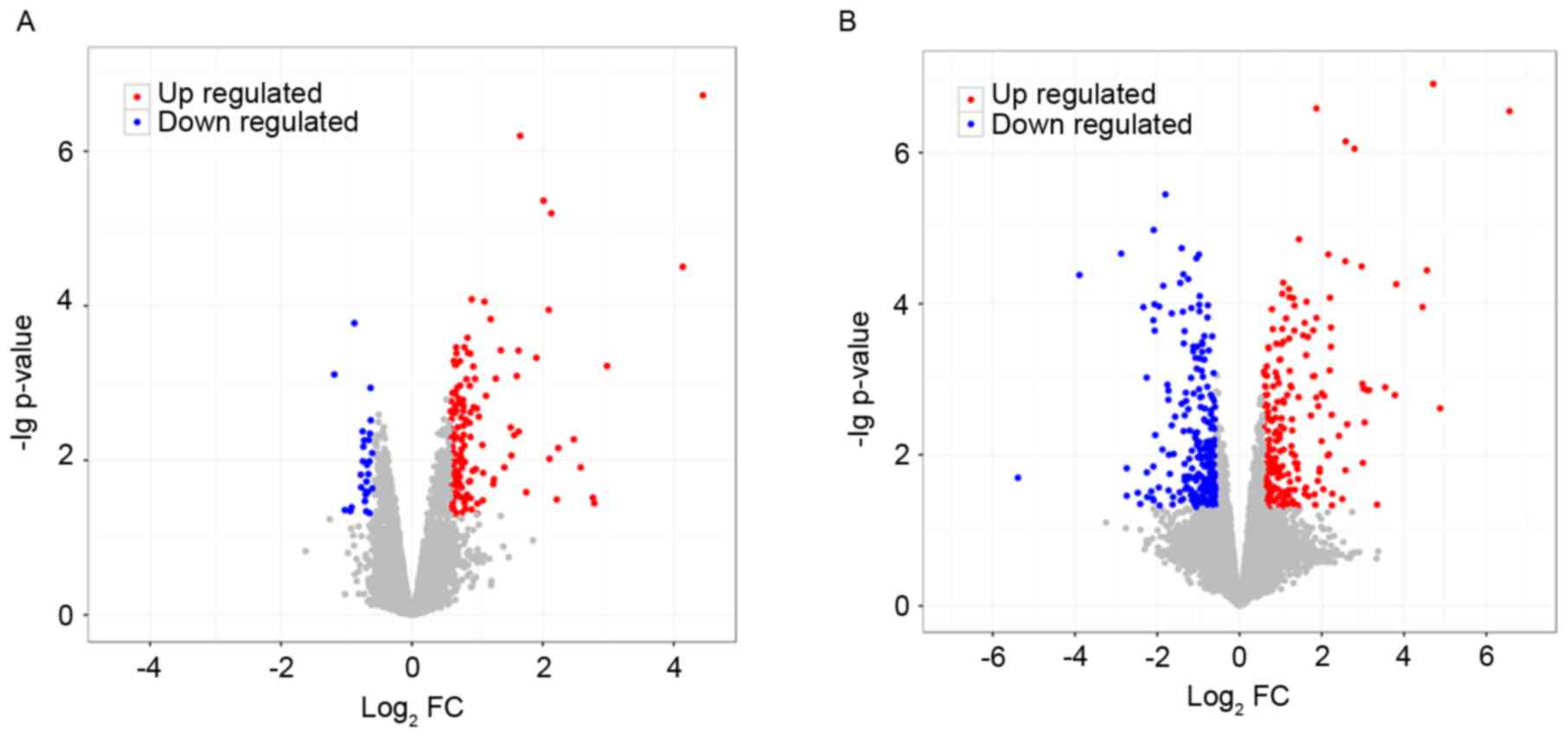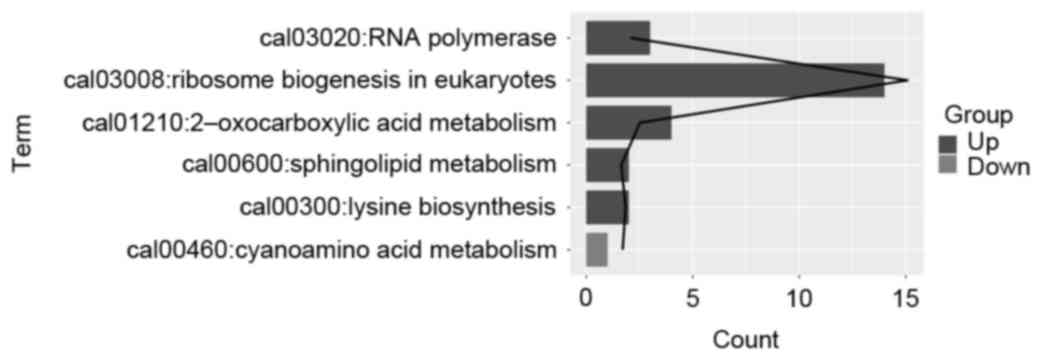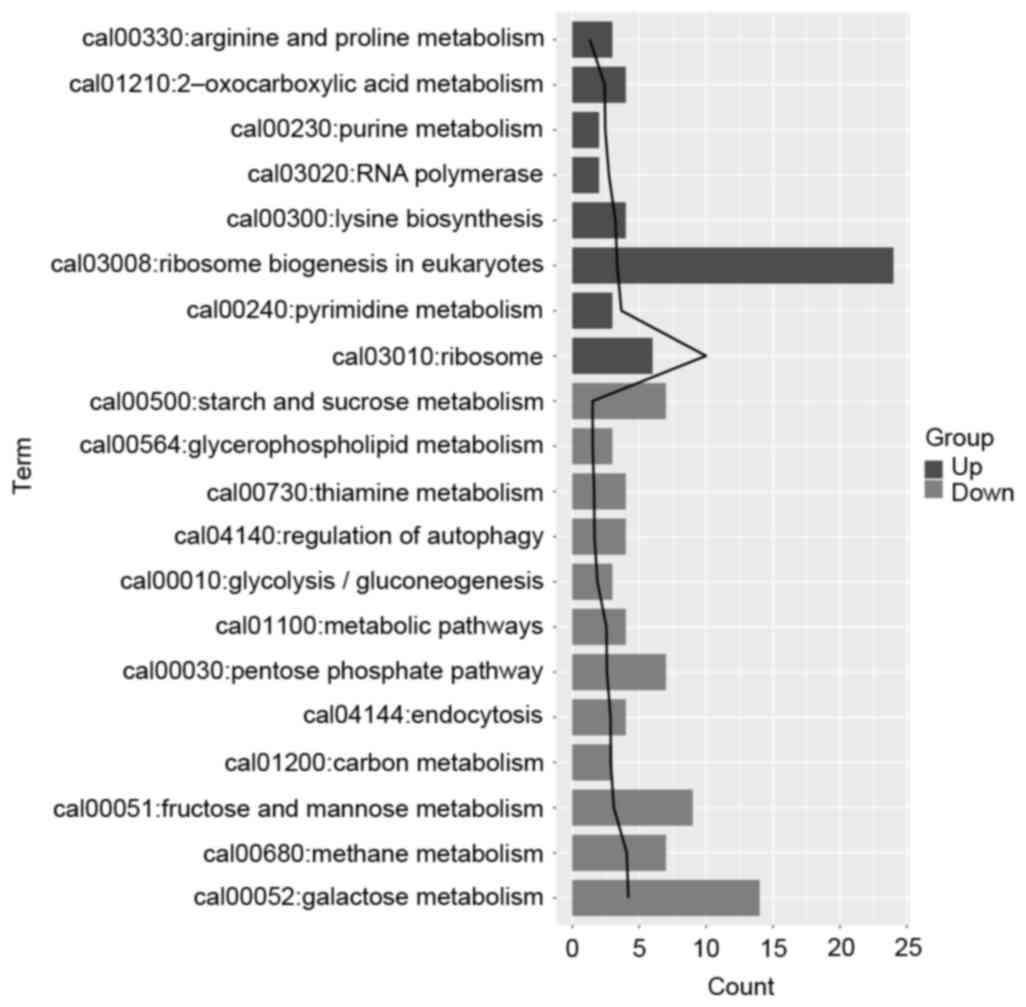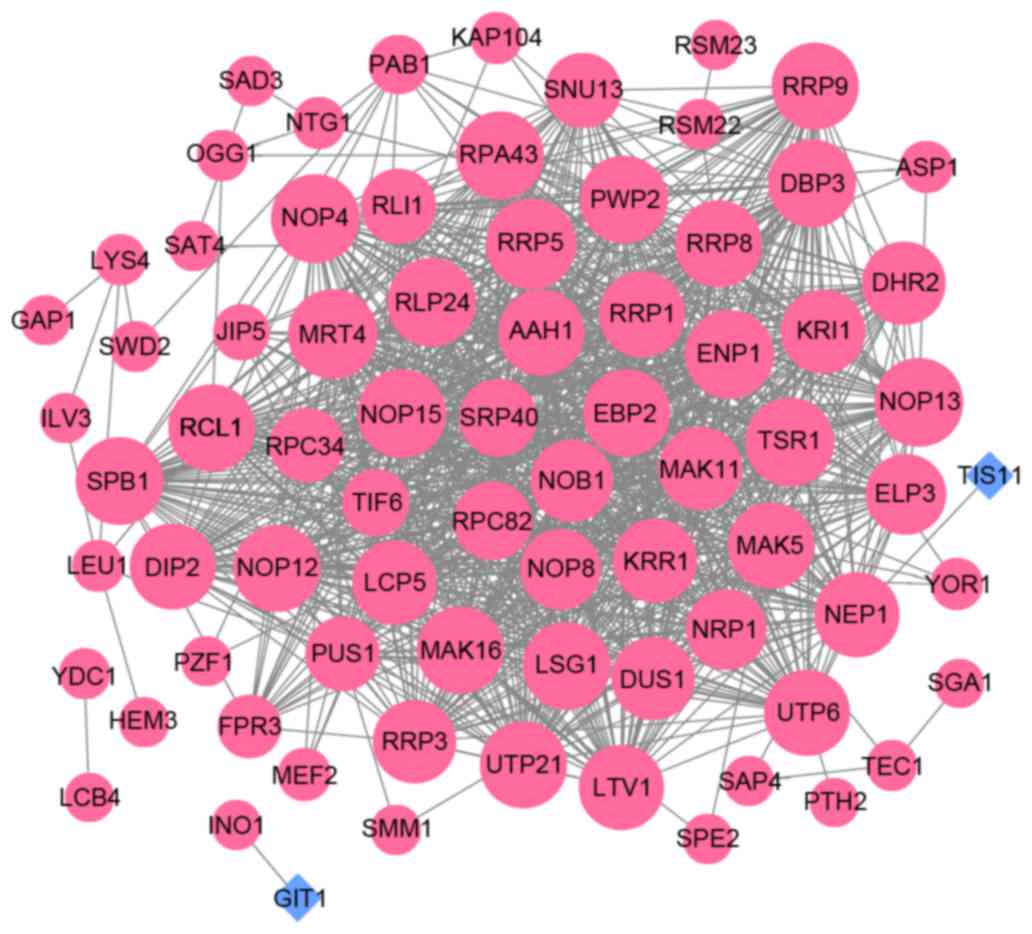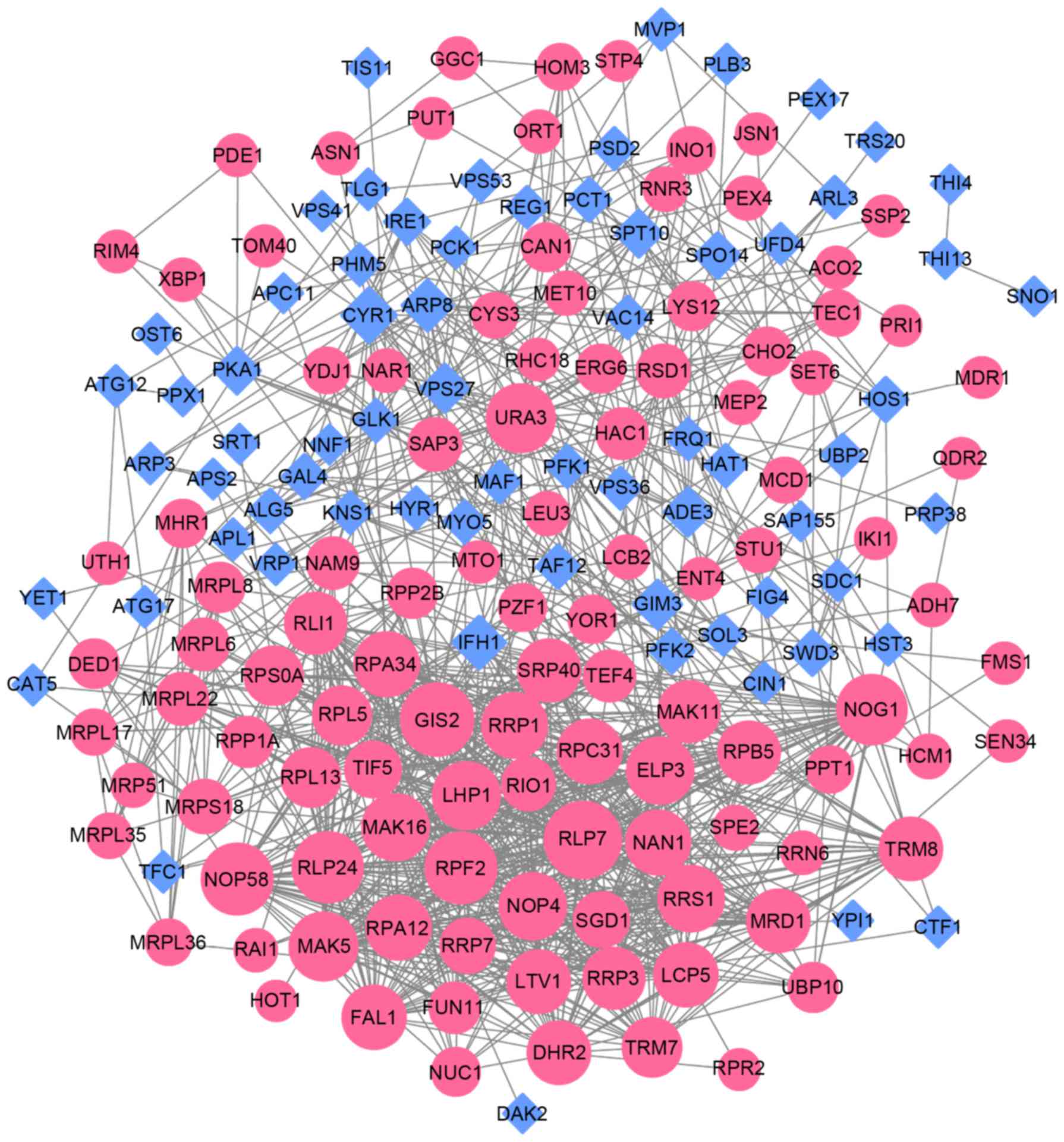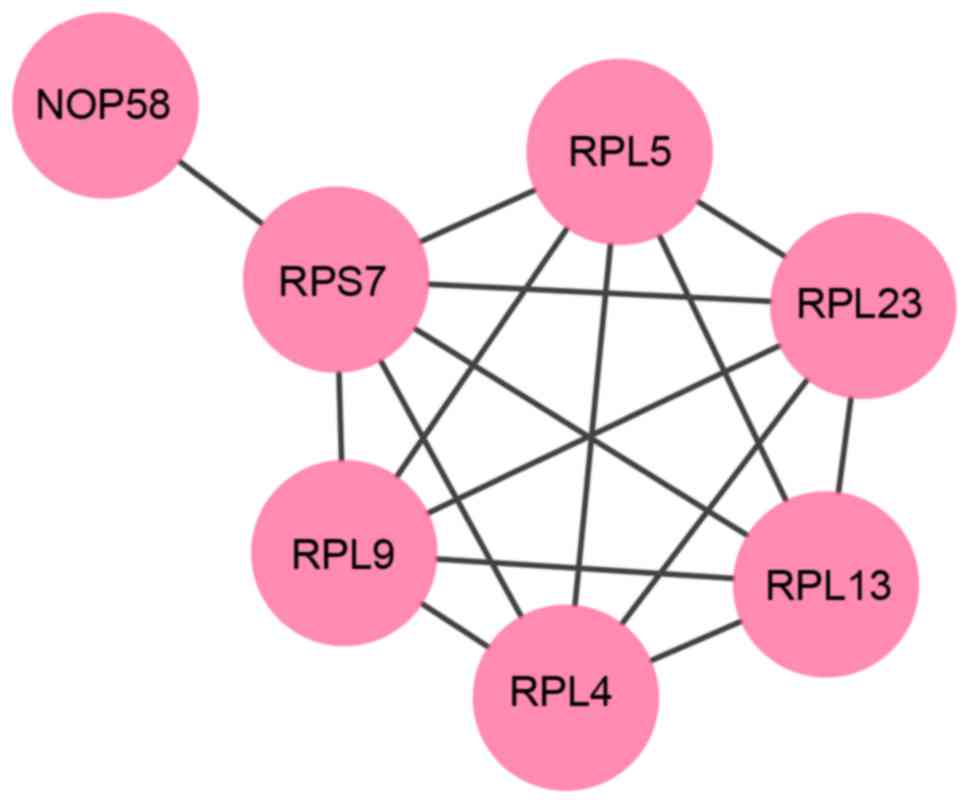Screening of potential genes contributing to the macrocycle drug resistance of C. albicans via microarray analysis
- Authors:
- Published online on: September 20, 2017 https://doi.org/10.3892/mmr.2017.7562
- Pages: 7527-7533
-
Copyright: © Yang et al. This is an open access article distributed under the terms of Creative Commons Attribution License.
Abstract
Introduction
Candida albicans (C. albicans) is a common commensal fungus which is normally accumulated in the oral cavity, respiratory tract and gastrointestinal systems in low numbers in healthy individuals (1). C. albicans is one of the most frequent opportunistic fungal pathogens of candidiasis. According to data provided by the US National Health Care Safety Network, C. albicans is the fourth most common microorganism infection in US hospitals (2). It has been estimated that ~250,000–400,000 individuals succumb to C. albicans-associated mortality annually worldwide (3). Although there are several antifungal drugs available, including azoles, polyenes, allylamines and echinocandins (4), the efficiency of anti-infection therapy remains low and drug resistance is a predominant problem in clinical therapy (5). Therefore, it is essential to elucidatethe mechanism of C. albicans infection in order to provide novel insights into the clinical treatment of candidiasis.
Following the identification of C. albicans, studies have investigated the processes involved in its infection and methods against infection. Generally, candidiasis is not detected in healthy individuals but is frequently detected in individuals who are immunocompromised to a certain extent, including babies, children, the elderly and patients suffering from immune system disease (6). Raska et al reported that the virulence factors secreted by C. albicans are one of the main factors enabling them to damage tissues and evade the immune system of the host (7). It has also been demonstrated that the transition of a yeast-like phenotype to a hyphal phenotype is an essential procedure for infection (8). pH, temperature and the ratio of oxygen/carbon dioxide in the microenvironment are also crucial in the process of C. albicans infection (9). Exposure to antifungal drugs is the main therapeutic approach for the candidiasis, however, due to thee overuse of antifungal drugs and the adaptive alteration of fungal genomes, the efficiency of clinical treatment remains low and the development of novel methods has been slow (10). Although, several studies have focused on the relevant factors, including cytokines, chemokines and effector cells, involved to obtain further insight into this process, information is lacking due to the restricted analysis (9). Therefore, it is important to gain a wider understanding of C. albicans.
To further analyze the alterations to the C. albicans transcriptome following treatment with macrocyclic compound FR59, Sanglard et al (10) generated a microarray of C. albicans (GSE65396) treated with 3 µM FR59 at the two time points of 15 and 45 min (https://www.ncbi.nlm.nih.gov/geo/query/acc.cgi?acc=GSE65396). In this microarray analysis, Sanglard et al showed that FR59 may induce a reduction in the expression of genes involved in cell wall biosynthesis, and that ATP binding cassette transporters may be involved in this process. This indicates that FR59 may be a promising drug for the treatment of candidiasis. However, the detailed reasons for this alteration to the cell wall remain to be elucidated. In order to obtain amore detailed understanding of C. albicans treated with FR59, the present study performed further analysis of the GSE65396 microarray. By performing this analysis, potential target genes or biofunctions may be identified, which may provide novel insights into the treatment of candidiasis.
Materials and methods
Gene expression profile
The gene expression profile of GSE65396 (https://www.ncbi.nlm.nih.gov/geo/query/acc.cgi?acc=GSE65396) for the macrocyclic compound RF59-treated C. albicans was downloaded from the Gene Expression Omnibus (http://www.ncbi.nlm.nih.gov/geo/), which was sequenced on the Agilent-037331 Copy of C. albicans assembly 21_017942 platform. This time profile contained three groups: 0 min control group, 15 min RF59-treated group and 45 min-RF59 treated group, with three repetitions in each.
Data processing
The Affy package (11) in R (Version 3.3.0, http://www.bioconductor.org/packages/release/bioc/html/affy.html) was used to read the raw data, the and RMA (12,13) method was used for data processing, including background correction, normalization and expression calculation. Annotation of the gene expression profile was performed to transform the probe IDs into gene symbols. In cases of different probes mapping to one gene, the mean value was considered to be the final expressed level of this gene.
Identification of differentially expressed genes (DEGs)
The Bayes test in the Limma (14) package was utilized to screen the DEGs of the 15 min group, vs. control; and the 45 min group, vs. control, P<0.05 and |log2 fold change >0.585 were considered to be significant.
Pathway enrichment analysis for DEGs
The Database for Annotation, Visualization and Integrated Discovery (DAVID) is a free database which uses an agglomeration algorithm to organize functionally related genes and terms into a manageable number of biological modules (15). Kyoto Encyclopedia of Genes and Genomes (KEGG) is a another free database for the systematic analysis of gene functions by linking current knowledge to cellular processes (16). In the present study, the DAVID online tool (Version 6.8, https://david-d.ncifcrf.gov/) was used to perform KEGG pathway enrichment analysis of DEGs. P<0.05 was set as the significance cut-off.
Protein-protein interaction (PPI) network
The Search Tool for Retrieval of Interacting Genes (STRING) is a precompute global database for the analysis and exploration of protein interaction (17). To further reveal the biofunctions of the identified DEGs, STRING (version 10.0, http://www.string-db.org/) was used to examine the interactions between differentially expressed proteins. The threshold was set as a required confidence >0.4.
Based on the results of the STRING analysis, Cytoscape (Version 3.2.0, http://www.cytoscape.org/) (18) was utilized to visualize the PPI network of differentially expressed proteins and the CytoNCA plug-in of Cytoscape (19) was used to perform topological analysis, including degree centrality (DC), betweenness centrality (BC) and closeness centrality (CC). Following calculation of the score of each node, the hub proteins in the PPI network were screened out (20).
Functional subnetwork analysis of DEGs
The ReactomeFI plug-in of Cytoscape is an application with a loaded gene expression profile and can be utilized to calculate the weights of edges in a PPI network. In the present study, ReactomeFI was used to compute the correlations as weights for the edges of the PPI network and was combined with the Markov Cluster Algorithm method to map significant functional subnetworks in the PPI network (21). Subsequently the DAVID online tool was used to perform KEGG pathway enrichment analyses for the selected subnetwork. P<0.05 was considered significant.
Results
Screening of DEGs
Following preprocessing and analysis, a total of 181 DEGs were identified in the 15-min treatment group, compared with the control group, which included 154 upregulated and 27 downregulated genes (Fig. 1A). A total of 468 DEGs were screened out in the 45-min treatment group, compared with the control group, which included 235 upregulated and 233 downregulated genes (Fig. 1B).
Functional enrichment analysis of DEGs
To further investigate the biofunctions of the DEGs, KEGG pathway enrichment analysis was performed. The results showed that the upregulated DEGs in the 15-min treatment group were significantly enriched in functions, which included ribosome biogenesis in eukaryotes (P=8.28E-16), oxocarboxylix acid metabolism (P=0.003), and RNA polymerase (P=0.009). The downregulated DEGs were significantly enriched in cyanoamino acid metabolism (P=0.020), as show in Fig. 2. The upregulated DEGs in the 45-min treatment group were significantly enriched in functions, which included ribosome (P=1.03E-10), pyrimidine metabolism (P=2.14E-04) and ribosome biogenesis in eukaryotes (P=4.39E-04). The downregulated DEGs were significantly enriched in functions, which included galactose metabolism (P=6.49E-05), methane metabolism (P=8.45E-05), and fructose and mannose metabolism (P=7.88E-04), as shown in Fig. 3.
PPI network analysis
Due to the deficiency of C. albicans data in STRING, the profile of Saccharomyces cerevisiae (S. cerevisiae) was used. According to the biofunctions of the DEGs, the PPI network of the 15-min treatment group was constructed, which contained 76 nodes and 975 edges (Fig. 4). Based on the scores from the topological analysis, PRP5 (DC=48, BC=273.754, CC=0.185), RCL1 (DC=44, BC=456.142, CC=0.184), NOP13 (DC=46, BC=116.109, CC=0.184), MRT4 (DC=47, BC=87.329, CC=0.184) and NOP4 (DC=46, BC=40.931, CC=0.184) were the top five nodes in the PPI network (Table I). The PPI network of the 45-min treatment group was also constructed, containing 177 nodes and 1,051 edges (Fig. 5). According to the scores from the topological analysis, GIS2 (DC=44, BC=4461.883, CC=0.202), URA3 (DC=38, BC=4507.660, CC=0.203), NOP58 (DC=42, BC=806.258, CC=0.200), ELP3 (DC=36, BC=1725.969, CC=0.198) and PLP7 (DC=49, BC=1129.925, CC=0.197) were the top five nodes in the PPI network (Table II). NOP4 and ELP3 were two shared genes within the top 20 of the two comparisons.
Table I.Top 15 nodes identified in the topological analysis of the 15-min treatment protein-protein interaction network. |
Table II.Top 15 nodes identified in topological analysis of the 45-min treated protein-protein interaction network. |
Functional subnetwork analysis
Following analysis using the ReactomeFI plugin, a significantly functional subnetwork of the 45-min treatment group was identified with an average correlation of 0.969. In this subnetwork, seven nodes and 16 edges were included (Fig. 6). All of these nodes were upregulated and significantly enriched in the ribosome pathway (P=2.08E-11).
Discussion
According to the analytical criteria, a total of 181 DEGs were identified in the 15-min treatment group, compared with the control group, which included 154 upregulated and 27 downregulated genes. A total of 468 DEGs were identified in the 45-min treatment group, compared with the control group, which included 235 upregulated and 233 downregulated genes. Between these two comparisons, the upregulated DEGs were significantly enriched in ribosome related pathways. Based on the PPI network analysis, PRP5, RCL1, NOP13, MRT4 and NOP4 were the top five nodes in the PPI network of the 15-min treatment group. GIS2, URA3, NOP58, ELP3 and PLP7 were the top five nodes in the PPI network of the 45-min treatment group. NOP58 showed significant involvement in the subnetwork, which was significantly enriched in the ribosome pathway.
Based on the PPI network analysis, RCL1 and MRT4 were two hub nodes in the 15-min treatment group. RCL1 is an RNA 3′-terminal phosphate cyclase, which is similar to S. cerevisiae RCL1 involved in rRNA processing (22). It has been demonstrated that RCL1 can interact with an important GTPase, Bms1, having an essential role in the process of 18S rRNA biogenesis (23). In addition, Delprato et al reported that the RCL1-Bms1complex is crucial in the pre-ribosomal RNA processing of yeast (24). In the present study, a significant upregulation was identified in C. albicans following treatment with RF59 for 15 min. Enjalbert et al demonstrated that RCL1 is a core stress genes under oxidative, osmotic and heavy metal stress in C. albicans (25). These results indicate that the upregulation of RCL1 may be key in rRNA biosynthetic processing. With this alteration, C. albicans may be able to adjust to a physiological status enabling improved response to stress from RF59. MRT4 was also identified as an upregulated node involved in the processing of rRNA in the PPI network of the 15-min treatment group. MRT4 is a non-essential nucleolar protein, which is involved in the biogenesis of the 60S r-subunit (26). Being homologous to the N-terminal domain of P0, Rodríguez-Mateos et al reported that MRT4 may have the same rRNA binding site as P0 in the process of ribosome synthesis (27). Rodriguez-Mateos et al also showed that MRT4 is a notable nucleolar component of the ribosome assembly process and shares a binding domain of 25S rRNA with P0 in S. cerevisiae (28). A study by Kressler et al indicated that MRT4 may also function in the assembly of the 60S stalk (29). Based on the above findings, MRT4 may be crucial in rRNA assembly under the restriction of RF59. With the combined biofunctions of RCL1 and MRT4, the increased biosynthesis of rRNA may be the initial response of C. albicans to RF59, and this transformation may assist in adapting to RF59 in the short-term exposure environment. The results of the KEGG analysis also showed that the upregulated genes were significantly enriched in the ribosomal and related pathways.
According to the PPI and subnetwork analyses, GIS2 and NOP58 were identified as two hub nodes in the 45-min treatment group. GIS, the DBA-binding zinc-finger protein (30), showed significant upregulation following treatment with RF59 for 45 min. Sammons et al reported that GIS2 can be upregulated by limiting glucose, and acts as a translational activator for mRNA within the internal ribosome entry site in S. cerevisiae (31). GIS2 has also been reported to be associated with the initiation and degradation of protein translation (32), and is reported to be key in ribosome biogenesis and cell size control in yeast (33). Taken together, it is hypothesized that GIS2 maybe crucial in ribosome related pathways. KEGG enrichment analysis for the subnetwork of the 45-min treatment group also showed that the involved genes were significantly enriched in the ribosome pathway. NOP58 was significantly upregulated in the 45-min treatment group. As a box C/D snoRNA binding protein, NOP58 and its homologue, NOP56, are required for pre-rRNA splicing and processing (34). NOP58 is also involved in the methylation of 18S rRNA (35). It has been reported that the overexpression of NOP58 in S. cerevisiae induces an increased resistance to CANBEF-13, which is a member of a novel family of selective antifungal compounds (35). These results indicate that NOP58 is crucial for rRNA processing and assembly. KEGG analysis for the subnetwork also revealed that the involved genes were significantly enriched in the ribosome pathway. Due to its sensitivity to RF-59, NOP58 maybe an important gene for RF-59-resistance.
NOP4 was identified as a shared upregulated protein in the two PPI networks. Sun and Woolford reported that NOP4 is a crucial NOP for the accumulation of 60S ribosomal subunits and pre-RNA processing (36). It has also been reported that NOP4 has four essential RNA recognition motifs, which are necessary for the biogenesis of ribosomes (37). With a deficiency of NOP4, the production of 27S pre-RNAs is normalized but degraded rapidly, and this result may lead to a deficiency of mature 25S rRNA synthesis in yeast (36,38). However, the detailed biofunctions of NOP4 in C. albicans remain to be fully elucidated, and further investigation of NOP4 in C. albicans is required.
From the in silico analysis, it was identified that RF59 can act as an antifungal drug to inhibit the infection of C. albicans via affecting ribosomal and related pathways, however, there were limitations to the present study. Although a series of DEGs were found to be important in the drug resistance of C. albicans, there remains a lack of experimental verification of these. In addition, the sample size in each group was three, and this maybe not sufficient to draw a valid conclusion. Finally, as drug resistance was found to be the result of long-term drug use, a longer treated duration may be considered.
In conclusion, RF59 maybe a promising therapeutic drug for candidiasis via acting on the ribosome and its associated pathways in C. albicans. RCL1, NOP4, MRT4, GIS2 and NOP58 may be important during this procedure. It is essential to further investigate the detailed biofunctions of these genes in C. albicans in order to provide novel insights into the pathogenesis of candidiasis and its therapy.
Acknowledgements
The present study was supported by the Research and Development Key Projects of Shanxi Province (grant no. 201603D321063), the Basic Research Project supported by ShanXi Province, China (grant no. 201701D121171), the Institutions of Higher Learning Innovation Project of Shanxi Province, China (grant no. 20161118), and the Research Project Supported by the Health and Family Planning Commission of Shanxi Province, China (grant no. 201601050).
Glossary
Abbreviations
Abbreviations:
|
DEGs |
differentially expressed genes |
|
KEGG |
Kyoto Encyclopedia of Genes and Genomes |
|
DAVID |
Database for Annotation, Visualization and Integrated Discovery |
|
DC |
degree centrality |
|
BC |
betweenness centrality |
|
CC |
closeness centrality |
References
|
Lara HH, Romero-Urbina DG, Pierce C, Lopez-Ribot JL, Arellano-Jiménez MJ and Jose-Yacaman M: Effect of silver nanoparticles on Candida albicans biofilms: An ultrastructural study. J Nanobiotechnology. 13:912015. View Article : Google Scholar : PubMed/NCBI | |
|
Yapar N: Epidemiology and risk factors for invasive candidiasis. Ther Clin Risk Manag. 10:95–105. 2014. View Article : Google Scholar : PubMed/NCBI | |
|
Kullberg BJ and Arendrup MC: Invasive candidiasis. N Engl J Med. 373:1445–1456. 2015. View Article : Google Scholar : PubMed/NCBI | |
|
Odds FC, Brown AJ and Gow NA: Antifungal agents: Mechanisms of action. Trends Microbiol. 11:272–279. 2003. View Article : Google Scholar : PubMed/NCBI | |
|
Sharma M, Biswas D, Kotwal A, Thakuria B, Kakati B, Chauhan BS and Patras A: Ibuprofen-mediated reversal of fluconazole resistance in clinical isolates of Candida. J Clin Diagn Res. 9:DC20–DC22. 2015.PubMed/NCBI | |
|
Magnuson JG: Potential role of RTA3 and GNP3 transport genes in the quorum sensing response of Candida albicans. 2015. | |
|
Raska M, Běláková J, Krupka M and Weigl E: Candidiasis-Do we need to fight or to tolerate the Candida fungus? Folia Microbiol (Praha). 52:297–312. 2007. View Article : Google Scholar : PubMed/NCBI | |
|
Soll DR: The role of phenotypic switching in the basic biology and pathogenesis of Candida albicans. J Oral Microbiol. 6:2014. View Article : Google Scholar : PubMed/NCBI | |
|
Vandeputte P, Ischer F, Sanglard D and Coste AT: In vivo systematic analysis of Candida albicans Zn2-Cys6 transcription factors mutants for mice organ colonization. PLoS One. 6:e269622011. View Article : Google Scholar : PubMed/NCBI | |
|
Sanglard D, Coste A and Ferrari S: Antifungal drug resistance mechanisms in fungal pathogens from the perspective of transcriptional gene regulation. FEMS Yeast Res. 9:1029–1050. 2009. View Article : Google Scholar : PubMed/NCBI | |
|
Gautier L, Cope L, Bolstad BM and Irizarry RA: affy-analysis of Affymetrix GeneChip data at the probe level. Bioinformatics. 20:307–315. 2004. View Article : Google Scholar : PubMed/NCBI | |
|
Bolstad BM, Irizarry RA, Astrand M and Speed TP: A comparison of normalization methods for high density oligonucleotide array data based on variance and bias. Bioinformatics. 19:185–193. 2003. View Article : Google Scholar : PubMed/NCBI | |
|
Irizarry RA, Hobbs B, Collin F, Beazer-Barclay YD, Antonellis KJ, Scherf U and Speed TP: Exploration, normalization, and summaries of high density oligonucleotide array probe level data. Biostatistics. 4:249–264. 2003. View Article : Google Scholar : PubMed/NCBI | |
|
Smyth GK: LIMMA: Linear models for microarray dataBioinformatics and Computational Biology Solutions Using R and Bioconductor. Gentleman R, Carey V, Huber W, Irizarry R and Dudoit S: Springer-Verlag New York; New York, NY: pp. 397–420. 2005, View Article : Google Scholar | |
|
Huang DW, Sherman BT, Tan Q, Collins JR, Alvord WG, Roayaei J, Stephens R, Baseler MW, Lane HC and Lempicki RA: The DAVID gene functional classification tool: A novel biological module-centric algorithm to functionally analyze large gene lists. Genome Biol. 8:R1832007. View Article : Google Scholar : PubMed/NCBI | |
|
Kanehisa M and Goto S: KEGG: Kyoto encyclopedia of genes and genomes. Nucleic Acids Res. 28:27–30. 2000. View Article : Google Scholar : PubMed/NCBI | |
|
Von Mering C, Huynen M, Jaeggi D, Schmidt S, Bork P and Snel B: STRING: A database of predicted functional associations between proteins. Nucleic Acids Res. 31:258–261. 2003. View Article : Google Scholar : PubMed/NCBI | |
|
Shannon P, Markiel A, Ozier O, Baliga NS, Wang JT, Ramage D, Amin N, Schwikowski B and Ideker T: Cytoscape: A software environment for integrated models of biomolecular interaction networks. Genome Res. 13:2498–2504. 2003. View Article : Google Scholar : PubMed/NCBI | |
|
Tang Y, Li M, Wang J, Pan Y and Wu FX: CytoNCA: A cytoscape plugin for centrality analysis and evaluation of protein interaction networks. Biosystems. 127:67–72. 2015. View Article : Google Scholar : PubMed/NCBI | |
|
He X and Zhang J: Why do hubs tend to be essential in protein networks? PLoS Genet. 2:e882006. View Article : Google Scholar : PubMed/NCBI | |
|
Wu G, Dawson E, Duong A, Haw R and Stein L: ReactomeFIViz: A Cytoscape app for pathway and network-based data analysis. Version 2. F1000Res. 3:1462014.PubMed/NCBI | |
|
Genschik P, Billy E, Swianiewicz M and Filipowicz W: The human RNA 3′-terminal phosphate cyclase is a member of a new family of proteins conserved in Eucarya, Bacteria and Archaea. EMBO J. 16:2955–2967. 1997. View Article : Google Scholar : PubMed/NCBI | |
|
Horn DM, Mason SL and Karbstein K: Rcl1 protein, a novel nuclease for 18 S ribosomal RNA production. J Biol Chem. 286:34082–34087. 2011. View Article : Google Scholar : PubMed/NCBI | |
|
Delprato A, Al Kadri Y, Pérébaskine N, Monfoulet C, Henry Y, Henras AK and Fribourg S: Crucial role of the Rcl1p-Bms1p interaction for yeast pre-ribosomal RNA processing. Nucleic Acids Res. 42:10161–10172. 2014. View Article : Google Scholar : PubMed/NCBI | |
|
Enjalbert B, Smith DA, Cornell MJ, Alam I, Nicholls S, Brown AJ and Quinn J: Role of the Hog1 stress-activated protein kinase in the global transcriptional response to stress in the fungal pathogen Candida albicans. Mol Biol Cell. 17:1018–1032. 2006. View Article : Google Scholar : PubMed/NCBI | |
|
Huh WK, Falvo JV, Gerke LC, Carroll AS, Howson RW, Weissman JS and O'Shea EK: Global analysis of protein localization in budding yeast. Nature. 425:686–691. 2003. View Article : Google Scholar : PubMed/NCBI | |
|
Rodríguez-Mateos M, Abia D, García-Gómez JJ, Morreale A, de la Cruz J, Santos C, Remacha M and Ballesta JP: The amino terminal domain from Mrt4 protein can functionally replace the RNA binding domain of the ribosomal P0 protein. Nucleic Acids Res. 37:3514–3521. 2009. View Article : Google Scholar : PubMed/NCBI | |
|
Rodríguez-Mateos M, García-Gómez JJ, Francisco-Velilla R, Remacha M, de la Cruz J and Ballesta JP: Role and dynamics of the ribosomal protein P0 and its related trans-acting factor Mrt4 during ribosome assembly in Saccharomyces cerevisiae. Nucleic Acids Res. 37:7519–7532. 2009. View Article : Google Scholar : PubMed/NCBI | |
|
Kressler D, Hurt E, Bergler H and Bassler J: The power of AAA-ATPases on the road of pre-60S ribosome maturation-molecular machines that strip pre-ribosomal particles. Biochim Biophys Acta. 1823:92–100. 2012. View Article : Google Scholar : PubMed/NCBI | |
|
Jang Y, Lee H, Lee SW, Choi YS, Ahn BJ, Kim GH and Kim JJ: Cu(II)-induced molecular and physiological responses in the brown-rot basidiomycete Polyporales sp. KUC9061. J Appl Microbiol. 113:790–797. 2012. View Article : Google Scholar : PubMed/NCBI | |
|
Sammons MA, Samir P and Link AJ: Saccharomyces cerevisiae Gis2 interacts with the translation machinery and is orthogonal to myotonic dystrophy type 2 protein ZNF9. Biochem Biophys Res Commun. 406:13–19. 2011. View Article : Google Scholar : PubMed/NCBI | |
|
Matia-González AM and Gerber AP: Approaches for dissecting RNA-binding protein networks. Fungal RNA Biology. 347–370. 2014. View Article : Google Scholar | |
|
Scherrer T, Femmer C, Schiess R, Aebersold R and Gerber AP: Defining potentially conserved RNA regulons of homologous zinc-finger RNA-binding proteins. Genome Biol. 12:R32011. View Article : Google Scholar : PubMed/NCBI | |
|
Anderson I, Göker M, Nolan M, Lucas S, Hammon N, Deshpande S, Cheng JF, Tapia R, Han C, Goodwin L, et al: Complete genome sequence of the hyperthermophilic chemolithoautotroph Pyrolobus fumarii type strain (1A). Stand Genomic Sci. 4:381–392. 2011. View Article : Google Scholar : PubMed/NCBI | |
|
Mircus G, Albert N, Ben-Yaakov D, Chikvashvili D, Shadkchan Y, Kontoyiannis DP and Osherov N: Identification and characterization of a novel family of selective antifungal compounds (CANBEFs) that interfere with fungal protein synthesis. Antimicrob Agents Chemother. 59:5631–5640. 2015. View Article : Google Scholar : PubMed/NCBI | |
|
Sun C and Woolford JL Jr: The yeast NOP4 gene product is an essential nucleolar protein required for pre-rRNA processing and accumulation of 60S ribosomal subunits. EMBO J. 13:3127–3135. 1994.PubMed/NCBI | |
|
Sun C and Woolford JL Jr: The yeast nucleolar protein Nop4p contains four RNA recognition motifs necessary for ribosome biogenesis. J Biol Chem. 272:25345–25352. 1997. View Article : Google Scholar : PubMed/NCBI | |
|
Harnpicharnchai P, Jakovljevic J, Horsey E, Miles T, Roman J, Rout M, Meagher D, Imai B, Guo Y, Brame CJ, et al: Composition and functional characterization of yeast 66S ribosome assembly intermediates. Mol Cell. 8:505–515. 2001. View Article : Google Scholar : PubMed/NCBI |



